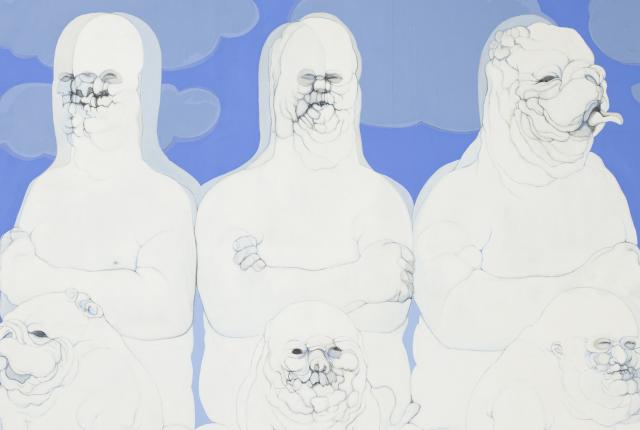May Stevens's work Metamorphosis is included in the retrospective exhibit May Stevens: Mysteries, Politics and Seas of Words at SITE Santa Fe through June 9. Courtesy of SITE Santa Fe.
View works by a feminist, activist, and artist.
In 1997, painter May Stevens moved to Eldorado, near Santa Fe, where her work shifted in the final years from politics to landscapes, occasionally featuring New Mexican scenes. A retrospective exhibition, May Stevens: Mysteries, Politics and Seas of Words, premieres at SITE Santa Fe on Friday and runs through June 9.
Stevens, who died in December 2019, built a career as an activist-artist focused on ideas about politics, war, and women’s rights. A founding member of Heresies: A Feminist Publication on Art and Politics and the Guerrilla Girls, the Massachusetts native believed art should serve as social commentary. Her series Big Daddy, for example, was an angry response to the Vietnam War. “The reason I am an artist is because it’s a place where you can be totally free,” she once said.
Lucy Lippard and Brandee Caoba curated the exhibit, which includes works from 1970 to 2010 and joins other exhibits throughout the country as part of the Feminist Art Coalition. “Stevens’s visually seductive waterscapes are more like places rather than pictures,” says Caoba. “They envelop the viewer with color, texture, and poetry, which glitter across the surfaces of her paintings, creating movement and flow.”
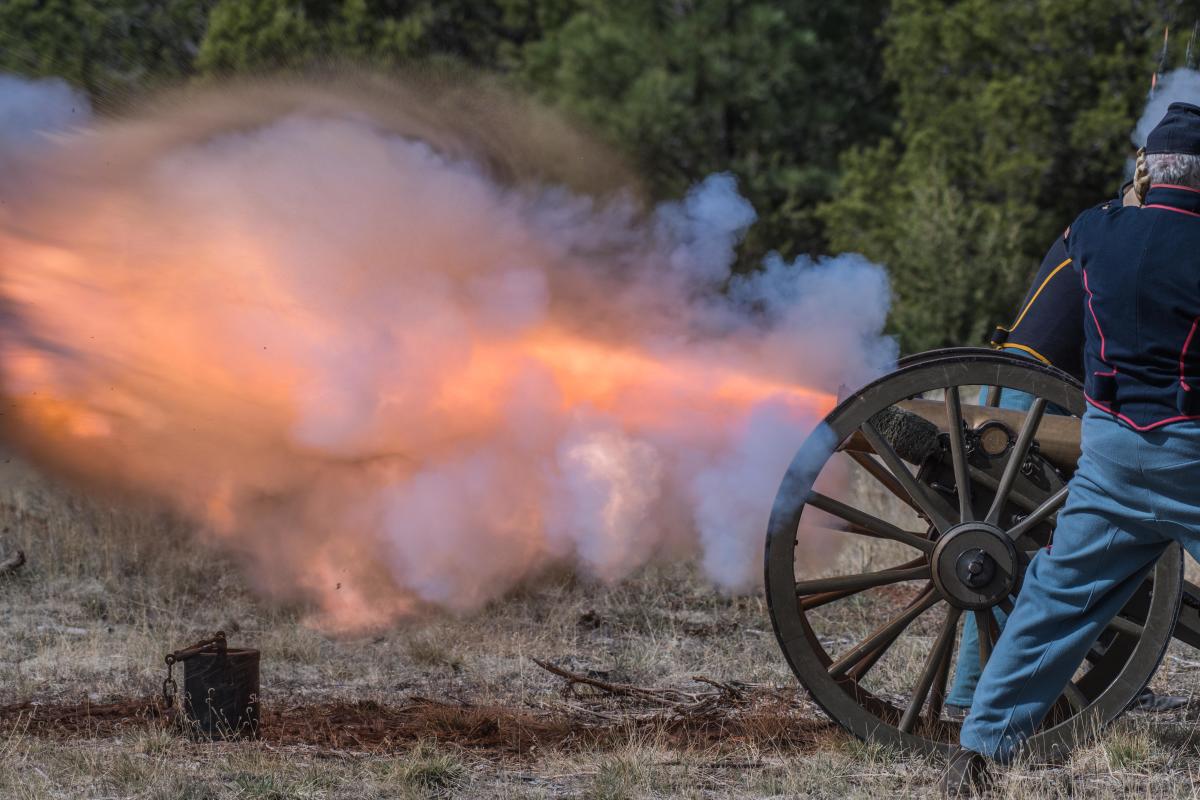 The virtual Civil War Encampment series features the Battle of Glorieta Pass. Courtesy of Friends of the Pecos National Historic Park.
The virtual Civil War Encampment series features the Battle of Glorieta Pass. Courtesy of Friends of the Pecos National Historic Park.
Engage in a battle of words.
The Battle of Glorieta Pass was one of the most important clashes in the Civil War. In an attempt to secure the Santa Fe Trail through the Sangre de Cristo Mountains, about 1,300 Confederate troops, who had already taken Santa Fe and Albuquerque, met a similar force of Union soldiers at Glorieta Pass over two days in late March, 1862.
Often referred to as “The Gettysburg of the West,” it turned back the Confederate invasion of the New Mexico Territory—and barred their access to Colorado’s gold mines. While the number of combatants and casualties nowhere near rivaled those at Gettysburg, which saw more than 51,000 lives lost, many argue that the result was just as significant.
On Friday at 7 p.m., the Friends of Pecos National Historical Park brings together Gettysburg National Military Park’s Chief of Interpretation Christopher Gwinn and Pecos National Historical Park volunteer Dr. Claudia Floyd to debate whether the battle’s title is warranted. It’s the final installation of a weeklong virtual Civil War Encampment series.
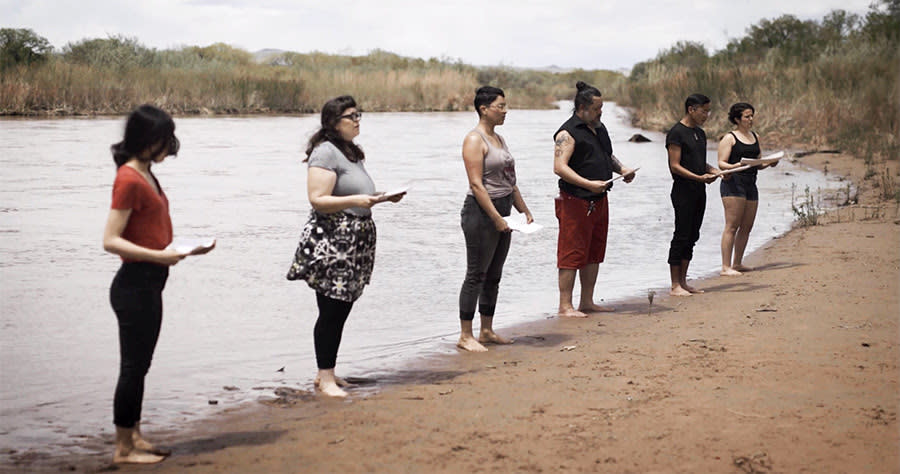 Singers stand on the edge of the Rio Grande to create a melody symbolizing the river flow. Courtesy of the University of New Mexico.
Singers stand on the edge of the Rio Grande to create a melody symbolizing the river flow. Courtesy of the University of New Mexico.
Listen to the river.
With decreasing winter snowpack and drought predicted this summer, the Río Grande may run dry between Bernalillo and Albuquerque this summer. Dire conditions surrounding the river inspired artists Marisa Demarco, Dylan McLaughlin, and Jessica Zeglin to craft a new sound-based video installation and community space, There Must Be Other Names For The River.
The trio met in an art and ecology class at the University of New Mexico. Inspired by the environmental reporting of Laura Paskus, whose book At the Precipice: New Mexico's Changing Climate debuted last year, they compiled streamflow data from the Río Grande going back 50 years and used it to forecast 2,000 years into the future. The data served as inspiration for a 22-minute vocal performance with six Albuquerque musicians.
“The piece is a meditation on what it’s like to live in relationship to a river that is in crisis,” says McLaughlin. With the musicians’ feet on the edge of its waters, a single vocalist begins. Then the sound moves down the line until all six create a natural melody that echoes the river’s flow. A visual map of the data is overlaid with the vocalists’ songs. “We are providing all of this scientific information in a way that’s accessible,” says McLaughlin. “To hear it as a music piece rather than read it as an article, it affects your body differently.”
The UNM Art Museum will host an online conversation with the artists Friday at 4 p.m.
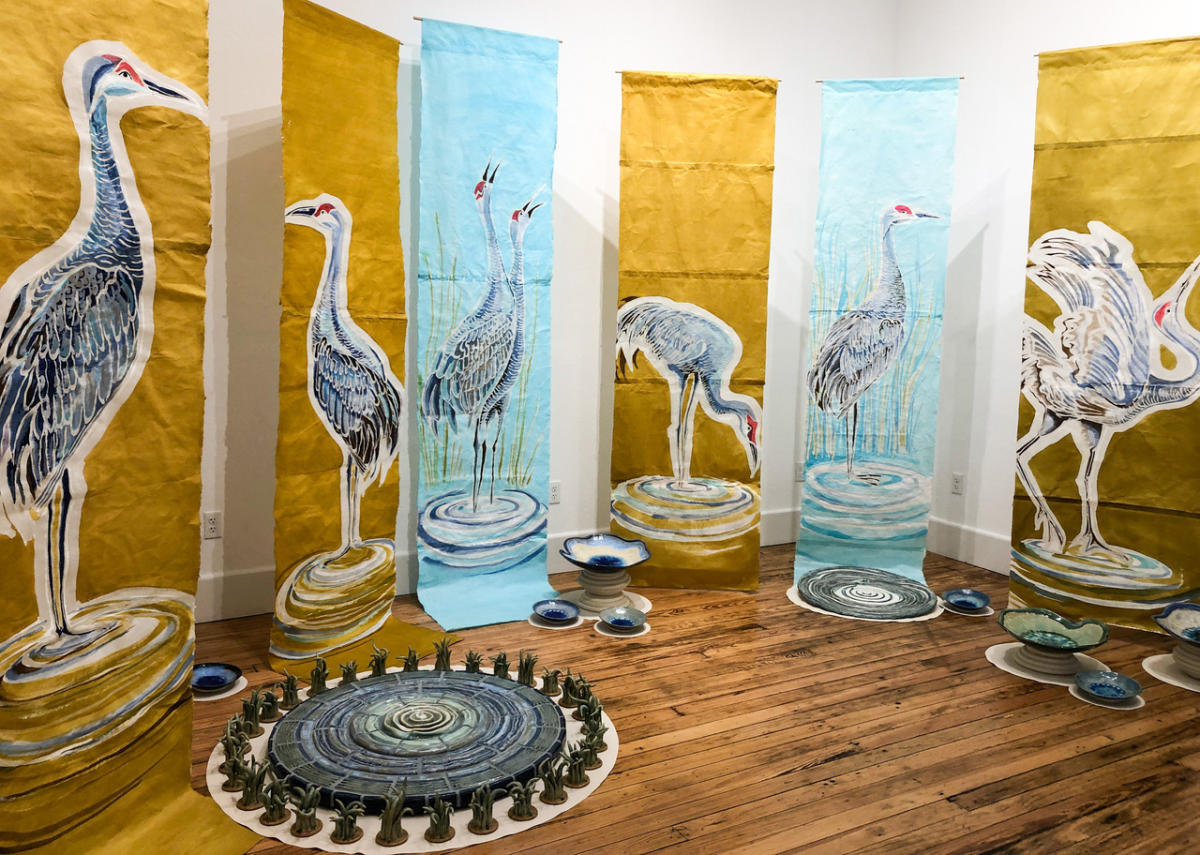 Artists Zoe Wolfe and Carlene Roters collaborated on Ode to Ancient Wings and Precious Water at the Light Art Space Gallery, in Silver City. Courtesy of Light Art Space Gallery.
Artists Zoe Wolfe and Carlene Roters collaborated on Ode to Ancient Wings and Precious Water at the Light Art Space Gallery, in Silver City. Courtesy of Light Art Space Gallery.
Find calm with the cranes.
Paper sandhill cranes take flight over rippling ceramic pools in Ode to Ancient Wings and Precious Water at the Light Art Space Gallery, in Silver City. An homage to habitat, the mixed-media installation, which runs through April 17, features works by longtime friends and collaborators Zoe Wolfe and Carlene Roters. “A lot of art that’s come forth in the last year has been about COVID,” says Wolfe. “We wanted to do something that was nurturing and reminded us of who we are.”
The artists worked in separate studios throughout quarantine, sharing color samples and pieces in progress to forge a relationship between the works. Colors in Roters’s paper cranes mirror those in the ceramic pools, where Wolfe masterfully mimics water’s movement. A central pool features a mandala-inspired pattern, surrounded by little green ceramic plants. “There’s a two-person seat in the installation, and people go and sit with it,” Wolfe says. “It gives a sense of lifting the spirit.”
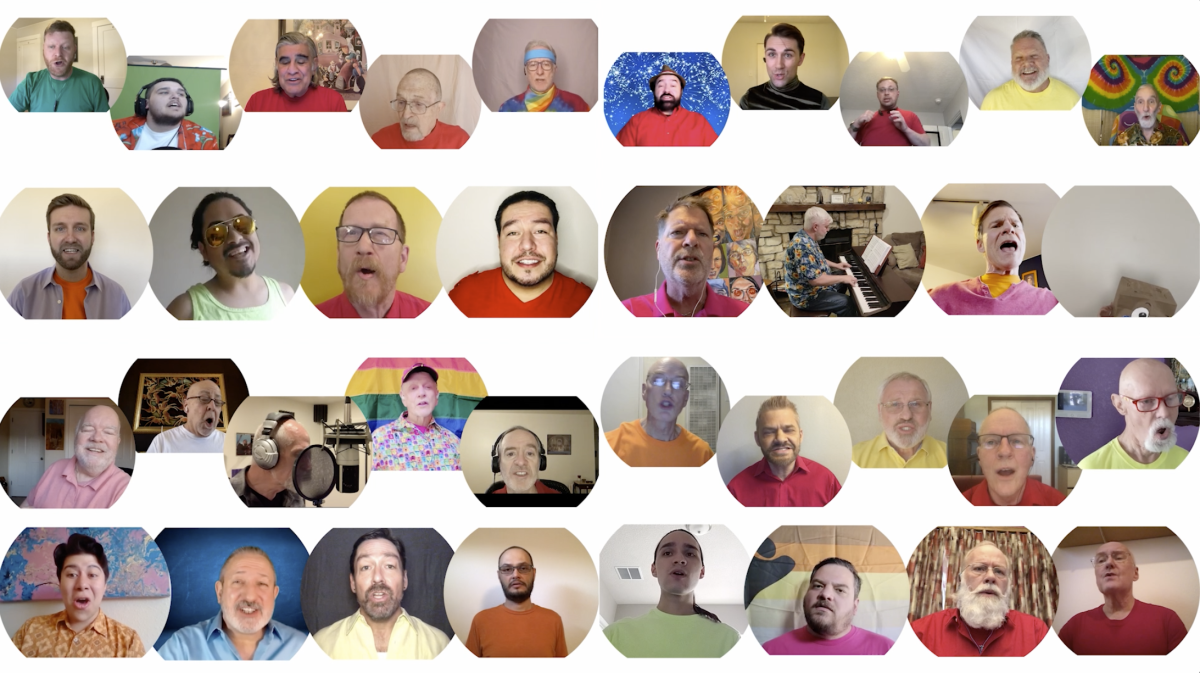 The New Mexico Gay Men’s Chorus presents Let the Sunshine In to celebrate the season. Courtesy of The New Mexico Gay Men’s Chorus.
The New Mexico Gay Men’s Chorus presents Let the Sunshine In to celebrate the season. Courtesy of The New Mexico Gay Men’s Chorus.
Sing into spring.
The New Mexico Gay Men’s Chorus welcomes spring with Let the Sunshine In, a pre-recorded musical celebration featuring optimistic hits suited for sunnier days. “We could have never imagined a world where we would have to create recordings and videos to connect with and delight our audiences wherever they are,” says Aaron Howe, director of the longtime group. “We hold onto the hope that we will be able to perform for them live soon.” The performances—Saturday at 7 p.m. and Sunday at 3 p.m.—are free with a suggested donation.


